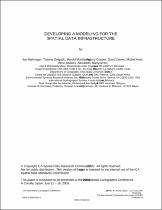 ResearchSpace
ResearchSpace
Are we achieving spatial transformation In South Africa? Can sub-city spatial indicators make a contribution?
JavaScript is disabled for your browser. Some features of this site may not work without it.
- ResearchSpace
- →
- Research Publications/Outputs
- →
- Conference Publications
- →
- View Item
Are we achieving spatial transformation In South Africa? Can sub-city spatial indicators make a contribution?
http://stepsa.org/pdf/planning_africa_2016/PAC_Spatial_Transformation_Indicators_JMfin.pdf
ttp://www.planningafrica.org.za/sites/default/files/SAPI_AbstractBook2016.pdf
http://hdl.handle.net/10204/9244
ttp://www.planningafrica.org.za/sites/default/files/SAPI_AbstractBook2016.pdf
http://hdl.handle.net/10204/9244
With the advent of a democratic order in South Africa in 1994 a number of policy frameworks have seen the light. All of these have indicated the need to spatially transform cities and settlements – to break from the pre-1994 apartheid city. Over time these frameworks change, new ones are developed which often state the same objectives. A major focus has also been placed on tracking their impact through spatial outcomes as set out in the Spatial Planning and Land Use Managemnet Act (SPLUMA), Act 16 of 2013 (Republic of South Africa, 2013) and also internationally through the recently introduced UN Sustainable Development Goals (SDGs) (United Nations Sustainable Development, 2016). A key question that remains is whether cities are succeeding in reinventing and restructuring the past. Vital in exploring progress regarding spatial transformation is investigating how the landscape within cities has changed spatially. To assess the progress made by South African cities in the last 20 years, the CSIR has embarked on developing a number of standardised repeatable sub-city level spatial indicators and/or indices to illustrate specific components of spatial change or transformation. This paper provides an overview of some of the innovations in spatially and temporally aligned sub-city indicator development within a data-scarce context. It also reflects on lessons learned, in the process providing some examples of spatial transformation analyses for a number of cities using the indicators developed. These Indicators have been developed partly in collaboration with the South African Cities Network (SACN) to support the 2016 State of Cities Report’s (SACN, 2016) theme on spatial transformation.
Reference:
Maritz, J., Van Huyssteen, E., Le Roux, A. et al. 2016. Are we achieving spatial transformation In South Africa? Can sub-city spatial indicators make a contribution? South African Planning Institute (SAPI): Planning Africa Conference 2016: Making Sense of the Future, 3-6 June 2016, Sandton Convention Centre, Johannesburg, South Africa
Maritz, J., Van Huyssteen, E., Le Roux, A., Pieterse, A., Ndaba, D., Mans, G. G., & Ngidi, M. (2016). Are we achieving spatial transformation In South Africa? Can sub-city spatial indicators make a contribution?. stepsa.org. http://hdl.handle.net/10204/9244
Maritz, Johan, Elsona Van Huyssteen, Alize Le Roux, Amy Pieterse, Dumisani Ndaba, Gerbrand G Mans, and Mawande Ngidi. "Are we achieving spatial transformation In South Africa? Can sub-city spatial indicators make a contribution?." (2016): http://hdl.handle.net/10204/9244
Maritz J, Van Huyssteen E, Le Roux A, Pieterse A, Ndaba D, Mans GG, et al, Are we achieving spatial transformation In South Africa? Can sub-city spatial indicators make a contribution?; stepsa.org; 2016. http://hdl.handle.net/10204/9244 .
South African Planning Institute (SAPI): Planning Africa Conference 2016: Making Sense of the Future, 3-6 June 2016, Sandton Convention Centre, Johannesburg, South Africa
This item appears in the following Collection(s)
Related items
Showing items related by title, author, creator and subject.
-
Author: Theron, Bertus ; El-Desouki, M ; Aljekhedab, FMR ; Alayed, MSI ; Alsawad, MSD Date: Apr 2013 A key imaging quality metric for an optical system (e.g. a camera or surveillance device) is its resolution. Methods to measure this, range from visual observation methods on resolution target charts, through more rigorous characterization, ... Read more
-
Author: Cooper, Antony K Date: Jun 1993 The purpose of this dissertation is to assess digital geo-referenced information and standards for exchanging such information, especially the South African National Exchange Standard (NES). The process of setting up a standard is exacting. ... Read more
-
Author: Hjelmager, J ; Delgado, T ; Moellering, H ; Cooper, Antony K ; Danko, D ; Huet, M ; Aalders, HJGL ; Martynenko, A Date: Jul 2005 The Commission on Spatial Data Standards of the International Cartographic Association (ICA) is working on defining spatial models and technical characteristics of a Spatial Data Infrastructure (SDI). To date, this work has been restricted ... Read more
Browse
-
All of ResearchSpace
-
This Collection
Legislation and compliance
General Enquiries
Tel: + 27 12 841 2911
Email: callcentre@csir.co.za
Physical Address
Meiring Naudé Road
Brummeria
Pretoria
South Africa
Postal Address
PO Box 395
Pretoria 0001
South Africa
Copyright © CSIR 2017. All Rights Reserved
Resources on this site are free to download and reuse according to associated licensing provision. Please read the terms and conditions of usage of each resource.







